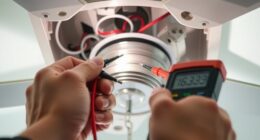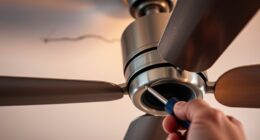To keep your home warm and cozy during winter, set your ceiling fan to rotate clockwise. This direction creates an updraft, pulling cold air up and pushing warm air back down to where you need it. Running the fan at low speed prevents chilly drafts, while promoting even heat distribution throughout the room. You can easily switch the fan's direction using the reversing switch on the fan body. By making this simple adjustment, you could save on heating costs and enhance your comfort level. There's more to optimizing your ceiling fan use during winter, so keep exploring!
Key Takeaways
- Set your ceiling fan to rotate clockwise during winter to create an updraft and distribute warm air effectively.
- Clockwise rotation helps pull cold air up and push warm air down, enhancing comfort.
- Operate the fan at low speed to avoid drafts while maintaining a cozy atmosphere.
- Adjust the fan's direction using the reversing switch or remote control before starting the heating season.
- Regular maintenance ensures optimal fan performance and contributes to energy efficiency during winter.
Importance of Ceiling Fan Direction

Many people don't realize how essential ceiling fan direction is during winter months. Setting your ceiling fan to a clockwise rotation can greatly enhance your comfort. By creating an updraft, the fan pulls cold air upward and forces warm air down towards the floor, ensuring that your space feels cozy.
This simple adjustment not only improves your comfort but also boosts energy efficiency, helping you save on heating costs by up to 10%.
Running your ceiling fan at a low speed is vital during winter, as it circulates warm air without creating drafts. This gentle airflow maintains a consistent temperature throughout the room, minimizing cold spots that can make winter nights uncomfortable.
Remember, adjusting the fan direction seasonally is key to optimizing airflow and maximizing heat distribution.
Most ceiling fans come equipped with a reversing switch conveniently located near the fan base, making it easy to change the direction as the seasons shift.
Recommended Direction for Winter

To keep your home cozy in winter, set your ceiling fan to rotate clockwise.
This direction creates an updraft that pushes warm air down, helping you reduce heating costs by up to 10%.
Just flip the reversing switch, and you'll enjoy a more comfortable living space without the chill.
Clockwise for Warmth
During winter, it's important to run your ceiling fan in a clockwise direction to enhance warmth in your living space. This ceiling fan direction creates an updraft that pulls cooler air upward, allowing warm air to be pushed down towards you.
By setting your fan to rotate clockwise at a low speed, you can effectively distribute warm air throughout the room without creating uncomfortable drafts.
The warm air circulation is vital during the winter months, as it helps maintain a consistent temperature. This method not only keeps you cozy but also supports temperature maintenance, ensuring your heating system doesn't have to work overtime.
To change the direction of your fan, simply locate the reversing switch, which is usually found on the fan body. Make sure the fan is turned off before making any adjustments.
Once you've set your fan to rotate clockwise, stand directly underneath it to confirm the blades move from top left to bottom right.
Energy Cost Reduction
Reducing energy costs is a key benefit of running your ceiling fan clockwise in winter. When you set your ceiling fan direction to clockwise and keep it at a low speed, it creates a gentle updraft that redistributes warm air trapped near the ceiling.
This simple adjustment can lead to a reduction in heating costs by up to 15%, as it helps maintain a consistent temperature throughout your living space.
Using the reversing switch on your fan, you can easily change the direction to clockwise, allowing the warm air to be pushed down into the room. This prevents heat pockets from forming and enhances your overall comfort.
With the warm air circulating effectively, you can feel more comfortable while keeping your thermostat at a lower setting.
In winter, a ceiling fan operating in the correct direction not only contributes to a cozy environment but also helps you save on energy costs. Additionally, energy-efficient technology can further enhance your heating system's effectiveness and reduce operational expenses.
By utilizing this strategy, you guarantee that your space remains warm and inviting without the need for excessive heating.
Benefits of Clockwise Rotation

Running your ceiling fan in a clockwise direction during winter offers several practical benefits. This ceiling fan direction creates a gentle updraft that pulls cold air upwards while pushing warm air down towards your living space.
With this clockwise rotation, you can enjoy energy savings of up to 15% on your heating bills as it promotes even heat distribution without causing cold drafts. Operating the fan at a low speed in winter guarantees that warm air is evenly distributed, enhancing overall comfort without creating uncomfortable wind chills.
By redistributing warm air near the ceiling, you can lower your thermostat settings, which helps reduce energy consumption and costs.
Furthermore, proper use of a ceiling fan in winter greatly lessens the strain on your heating system. This contributes to a longer lifespan and improved efficiency of your equipment.
By taking advantage of these benefits, you'll not only stay warm and cozy throughout the winter months but also enjoy substantial savings on your energy bills.
How to Change Fan Direction

Adjusting your ceiling fan for winter is a straightforward process that can enhance your comfort and energy savings. Follow these steps to change the direction of your fan:
- Turn Off the Fan: Safety first! Always turn off the fan and let it come to a complete stop before making any adjustments.
- Find the Reversing Switch: Locate the ceiling fan switch, usually found on the fan body. Push this switch to change the direction to clockwise for winter use.
- For Remote-Controlled Fans: If you have remote-controlled fans, verify your remote is paired. Turn off the fan, then press and hold the fan button until a light blinks, confirming the direction change.
- Using Smart Ceiling Fans: If you've got smart ceiling fans, adjust the direction via your mobile app or voice commands for added convenience.
Once you've changed the direction, turn on the fan at low speed to effectively distribute warm air throughout the room without creating uncomfortable drafts.
This simple adjustment can make a significant difference in your winter comfort!
Timing for Direction Adjustment

The best time to change your ceiling fan direction is during Daylight Savings Time, especially when you fall back in autumn.
This seasonal adjustment prepares your home for winter by allowing warm air to circulate efficiently.
Optimal Timing for Change
Changing your ceiling fan direction at the right time can markedly enhance your heating efficiency during winter. The ideal timing to change ceiling fan direction is typically during the Daylight Savings Time adjustment when you "fall back" in the fall. This change serves as a perfect reminder to set your fan to clockwise rotation to create a gentle updraft, pushing warm air down from the ceiling.
Here are some key points to keep in mind for effective timing:
- Adjust at Daylight Savings: Change your ceiling fan direction during the fall to align with seasonal changes.
- Set to Low Speed: For best results, keep the fan on low speed to avoid uncomfortable drafts while redistributing heat.
- Energy Savings: Expect up to 10% savings on heating costs by enhancing warm air distribution with the right fan direction.
- Maintain Indoor Comfort: Regular seasonal adjustments help keep consistent indoor temperatures, ensuring comfort throughout the colder months.
Seasonal Adjustment Reminders
As winter approaches, keeping track of when to adjust your ceiling fan direction becomes important for maintaining comfort and energy efficiency. A great reminder is to change your ceiling fan direction during Daylight Savings Time adjustments.
When you fall back, set your fan to clockwise rotation at a low speed. This creates a gentle updraft that redistributes warm air throughout the room without generating uncomfortable drafts.
By regularly changing the fan direction, you'll help maintain a comfortable environment while allowing for lower thermostat settings during the winter months. This simple seasonal adjustment can notably impact your heating bills, potentially saving you up to 15% when your ceiling fan is rotating correctly.
Make certain to check the fan's direction at the start of the heating season. This guarantees that you're optimizing energy efficiency and comfort throughout the winter.
Ceiling Fan Usage Tips

Maximizing your ceiling fan's efficiency during winter can lead to significant energy savings and enhanced comfort. By adjusting the ceiling fan direction to rotate clockwise at a low speed, you can create an updraft that circulates warm air down from the ceiling.
Here are some tips to optimize your fan usage:
- Set the fan to rotate clockwise: This helps redistribute warm air without creating cold drafts, improving comfort levels.
- Maintain proper height: Verify your fan is mounted at least 7-9 feet from the floor for effective air circulation.
- Regular maintenance: Clean the fan blades regularly and check for loose screws to keep it running efficiently throughout the winter months. Regular cleaning is essential to ensure optimal performance.
- Adjust thermostat settings: With the warm air circulation, you can lower your thermostat settings, which can reduce heating costs by up to 15%.
Energy Savings With Proper Direction

Properly directing your ceiling fan in winter can lead to remarkable energy savings. By setting your ceiling fan to rotate clockwise, you create a gentle updraft that helps redistribute warmer air that naturally rises to the ceiling. This proper fan direction allows you to lower your thermostat settings, which can considerably reduce heating bills while keeping your home comfortable.
Using ceiling fans in the winter is an energy-efficient choice—these fans consume only about 50 watts, while traditional heating systems use around 3,500 watts. By running your ceiling fan at a low speed, you enhance the circulation of warmer air without creating uncomfortable drafts. This simple adjustment can lead to improved heating efficiency and lower energy costs during colder months.
With the right ceiling fan direction winter can become a time of warmth and savings. Regularly adjusting your fan guarantees that you're maximizing energy savings and maintaining a cozy environment.
Embracing this practice not only helps your wallet but also promotes a more sustainable approach to heating your home. So, take a moment to verify your ceiling fans are set correctly this winter!
Common Misconceptions About Fan Use

While many homeowners associate ceiling fans solely with cooling during the summer, they can be just as beneficial for heating in the winter.
Understanding the common misconceptions about fan use can help you maximize your ceiling fan's efficiency and comfort in colder months.
Here are four key misconceptions:
- Fan direction doesn't matter: The ceiling fan direction plays a vital role. Running your fan clockwise helps circulate warm air trapped near the ceiling, leading to heating cost reductions.
- Fans should run on high speed: In winter, a low fan speed is ideal. It creates a gentle updraft, helping circulate air without causing uncomfortable drafts.
- Continuous operation is fine: Leaving your fan running without adjusting the direction can lead to inefficient heating, leaving you with cold spots in your room.
- Fans don't affect room temperature: Ceiling fans actively circulate air, ensuring a consistent and comfortable environment by mixing warm air throughout your space.
Frequently Asked Questions
What Direction Do I Rub My Ceiling Fan in the Winter?
When you want to adjust your ceiling fan for winter, you'll need to set it to rotate in a specific direction.
You should rub your ceiling fan blades clockwise. This direction helps create an updraft that pulls the cold air up and pushes warm air down towards the floor.
Remember to set it to a low speed, ensuring a warm, comfortable environment without any drafts disrupting your cozy space.
Is There Any Point in Using a Ceiling Fan in Winter?
Picture a warm hug on a chilly day; that's what using a ceiling fan in winter feels like.
Yes, there's a point! By running it at low speed, you can gently circulate warm air that naturally rises, making your space cozier.
You'll save up to 15% on heating bills while keeping your home comfortable.
What Direction Should a Ceiling Fan Go in Summer?
In summer, your ceiling fan should rotate counterclockwise. This direction creates a cooling downdraft, making the room feel up to 4 degrees cooler.
You'll appreciate the breeze it generates, which enhances comfort while reducing reliance on air conditioning. Running it at high speed can lead to energy savings of up to 30%.
Just stand under the fan to feel the airflow directed downward, confirming it's spinning in the right direction.
Which Way Should Fans Spin in Winter Reddit?
When you're cozying up in winter, you might wonder which way fans should spin.
It's a simple switch, really. While summer calls for counterclockwise to create a revitalizing breeze, winter's all about clockwise.
This gentle motion pulls cool air up, pushing warm air down, keeping your space comfy. You'll save on heating bills, too!
Just flip that reversing switch, and you'll feel the warmth circulate without the drafts. Enjoy the comfort!
Conclusion
In winter, adjusting your ceiling fan to rotate clockwise is like wrapping yourself in a cozy blanket, pushing warm air down to keep your space comfortable. By embracing this simple change, you'll not only enhance your comfort but also cut down on energy costs. Remember to switch the direction when the seasons change, and you'll find your fan is a valuable ally in maintaining the perfect atmosphere year-round. So, enjoy the warmth and efficiency a little adjustment can bring!









